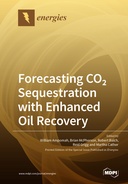Explore

Forecasting CO2 Sequestration with Enhanced Oil Recovery
0 Ungluers have
Faved this Work
Login to Fave
The aim of carbon capture, utilization, and storage (CCUS) is to reduce the amount of CO2 released into the atmosphere and to mitigate its effects on climate change. Over the years, naturally occurring CO2 sources have been utilized in enhanced oil recovery (EOR) projects in the United States. This has presented an opportunity to supplement and gradually replace the high demand for natural CO2 sources with anthropogenic sources. There also exist incentives for operators to become involved in the storage of anthropogenic CO2 within partially depleted reservoirs, in addition to the incremental production oil revenues. These incentives include a wider availability of anthropogenic sources, the reduction of emissions to meet regulatory requirements, tax incentives in some jurisdictions, and favorable public relations. The United States Department of Energy has sponsored several Regional Carbon Sequestration Partnerships (RCSPs) through its Carbon Storage program which have conducted field demonstrations for both EOR and saline aquifer storage. Various research efforts have been made in the area of reservoir characterization, monitoring, verification and accounting, simulation, and risk assessment to ascertain long-term storage potential within the subject storage complex. This book is a collection of lessons learned through the RCSP program within the Southwest Region of the United States. The scope of the book includes site characterization, storage modeling, monitoring verification reporting (MRV), risk assessment and international case studies.
This book is included in DOAB.
Why read this book? Have your say.
You must be logged in to comment.
Rights Information
Are you the author or publisher of this work? If so, you can claim it as yours by registering as an Unglue.it rights holder.Downloads
This work has been downloaded 92 times via unglue.it ebook links.
- 92 - pdf (CC BY) at Unglue.it.
Keywords
- 4D
- Anadarko
- anthropogenic CO2
- caprock integrity
- carbon dioxide storage
- Carbon sequestration
- carbon storage
- CO2
- CO2 and brine leakage
- CO2 leakage
- CO2 migration
- CO2 sequestration
- CO2-enhanced oil recovery
- CO2-EOR
- CO2-WAG
- early detection criteria
- enhanced oil recovery with CO2 (CO2-EOR)
- EOR
- expectation curve
- Farnsworth
- Farnsworth Field
- Farnsworth Unit
- GEM
- geochemical reactions
- geologic carbon storage
- geologic CO2 sequestration
- geological carbon sequestration
- geomechanics
- global warming potential
- greenhouse gas (GHG)
- hybrid workflows
- incised valley
- life cycle analysis
- Machine learning
- Mathematics & science
- mineral trapping
- Monitoring
- Monte Carlo
- morrow
- multi-objective optimization
- Multi-phase Flow Simulation
- multi-phase fluid flow
- n/a
- noble gas migration
- NRAP
- numerical modeling
- petroleum system modeling
- Physics
- polynomial chaos expansion
- probabilistic
- process influence diagram
- reactive solute transport
- reactive surface area
- Reference, information & interdisciplinary subjects
- relative permeability
- Research & information: general
- reservoir fluid flow modelling
- response surface methodology
- response surface model
- Risk assessment
- seal by-pass
- sequestration
- STOMP
- storage efficiency factor
- threshold pressure
- tightness of caprock
- time lapse
- TOUGHREACT
- underground source of drinking water
- WAG
- Workflow
- Workshop
Links
DOI: 10.3390/books978-3-0365-5916-2Editions

